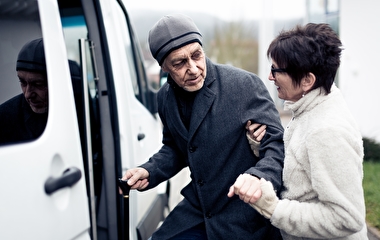
During the past century, a person’s average lifespan has increased dramatically. However, this significant “longevity bonus” has also led to challenges, including how to maintain mobility for an aging population.
Rural communities are experiencing outsized impacts from this shift, because older adults are more likely to live in rural areas where private vehicles are often the only reliable means of transportation. On April 15, CTS partnered with the U’s Center for Healthy Aging and Innovation (CHAI) for a webinar to explore transportation and aging, with special attention on the challenges and opportunities in rural areas. The event was part of CTS’s Rural Needs, Statewide Answers: Improving Transportation for All thematic focus for 2024.
The event began with a presentation from Massachusetts Institute of Technology (MIT) AgeLab research scientist Lisa D’Ambrosio, who offered a frank assessment of the challenges surrounding transportation and aging.
“Our lab started 25 years ago with the recognition that we had a growing older population who were very dependent on cars for getting around, and yet we didn’t have infrastructure or technologies designed to accommodate them,” D’Ambrosio said. “I’m here to report that 25 years later it’s still a challenge, and it’s not an easy problem to solve.”
Despite its complexity, D’Ambrosio said the problem is one we need to continue grappling with through additional research, technological innovation, and support for continued safe driving. “We know that driving is not simply a means to an end for older adults. It can represent freedom and autonomy,” D’Ambrosio added. “Transportation is the glue that holds our lives together. Without it you can’t get where you want to go, do the things you want to do, or see the people you want to see.”
Following D’Ambrosio’s presentation, four Minnesota panelists from diverse professional backgrounds shared their experiences and recommendations surrounding transportation for older adults in rural areas.
Michelle Lichtig, project manager with the Minnesota Department of Transportation’s Office of Transit and Active Transportation, emphasized the need for a community-wide approach in which the entire transportation and health network come together at a local level to discuss barriers and solutions to mobility for older adults. According to Lichtig, finding mobility solutions is not only important for health and equity, but also for maintaining strong rural communities.
“For many rural communities, when a group of older adults can access the bank, the grocery store, the beauty shop, and other community services, it really raises economic vitality,” Lichtig said. “Older adults are also the leaders of our rural communities—they are the structure of the web through which the vitality continues to grow.”
Volunteer drivers are one solution for transportation access in rural communities. However, panelist Terry Smith, regional transportation coordinator with the Mid-Minnesota Development Commission, noted that many older adults who were once volunteer drivers now need service themselves, and finding new volunteer drivers can be a challenge.
“Being one of the younger volunteer drivers myself, I’m always trying to convince folks to give it a try,” Smith said. “I often give presentations at safe driver discount courses and have recruited some volunteer drivers there. I think the drivers are out there, but it takes a while to turn those stones over and find them.”
Anjuli Cameron, a Metropolitan Council member, added that for older members of immigrant and refugee communities, the challenges of transportation can be even more significant. “We do have a growing population of communities of color in our rural areas, and transportation support for those communities is a significant concern,” Cameron said. “Transportation navigation can be very complex whether you have been a resident of Minnesota your entire life or you are new to this country, so having one-on-one support is important…for trying to navigate these services, particularly when you add in cultural and linguistic barriers.”
Moving forward, policy experts say the close examination of trends will help meet the needs of the older adults who most need transportation services. “At this point the local data doesn’t provide enough granular detail,” said Kelly Asche, senior researcher with the Center for Rural Policy and Development. “For example, it may show us where our older adults are living, but it doesn’t differentiate between those living in senior communities with lots of services available and those living independently in their own homes. We need more funding for our local organizations to really start filling in the data and mapping out an inventory of the services that are available, who needs services, and what the gaps are.”
—Megan Tsai, contributing writer


